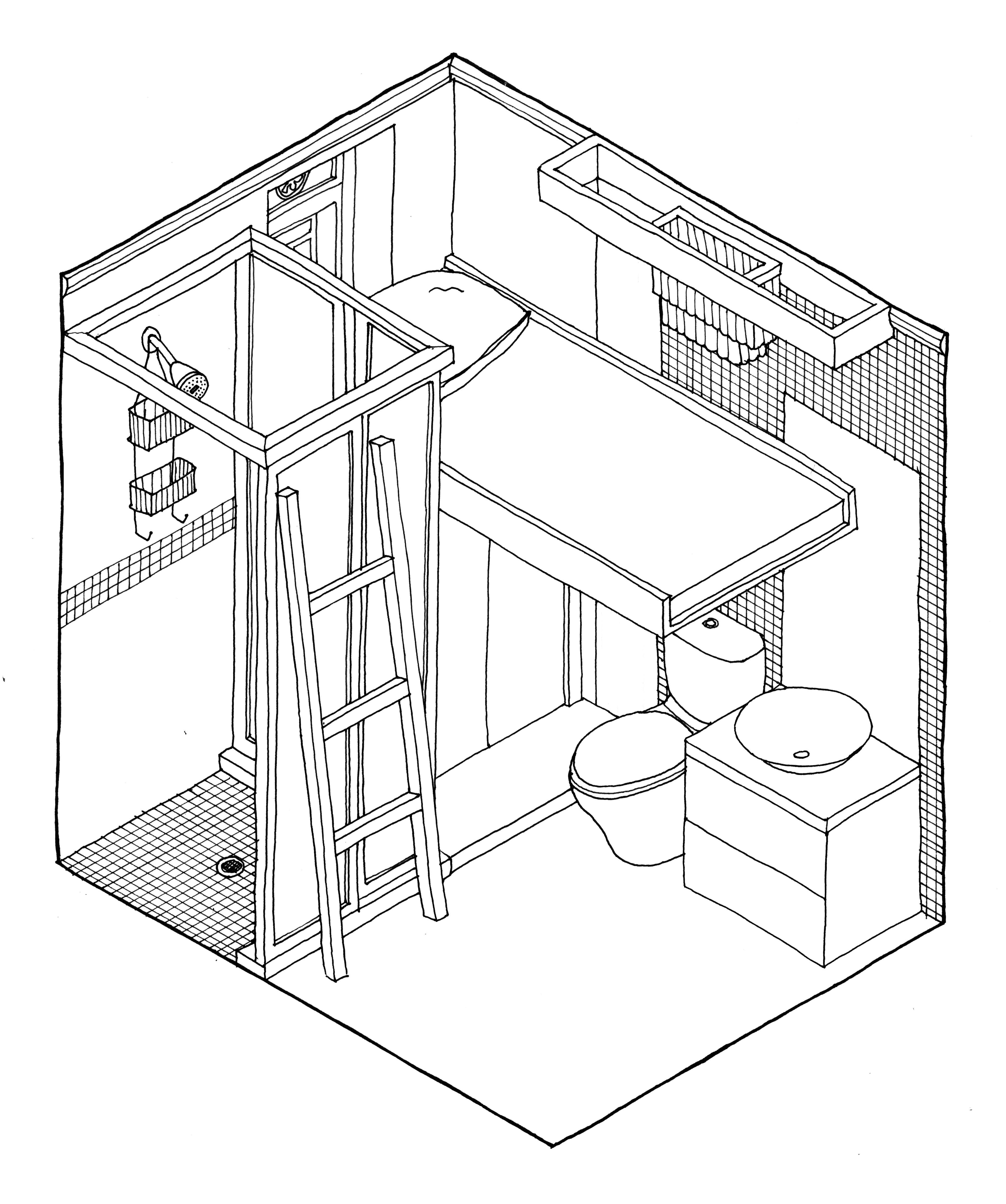
| Public Program | |
| Drop-in Drawing Sunday June 26, 2-5 pm (During Opening Reception of How to Make Space) The Central Oasis Gallery Central Market Public Passage 2/F 80 Des Voeux Road Central, Hong Kong In conjunction with apexart Franchise exhibition How to Make Space, organized by Rear View Projects (Jennifer Davis and Su-Ying Lee). How to Make Space artist and architect Tings Chak conducts this drop-in drawing session, open to all. Materials will be provided. When the house you live in is not necessarily your home, but a workplace, how do you find personal space? In this 3-hour drop-in workshop, we invite workers to participate in drawing, describing, and visualizing what their living conditions as domestic workers look like. This is a place to share diverse experiences in the daily lives of domestic workers, who live in shared bedrooms with the children and elderly whom they care for, storage rooms, makeshift bedrooms above toilets, corridors, and private rooms. |
 Tings Chak, Suitable Accommodation, 2016 |
|
“Is a maid’s bed different from any other kind of bed?” asks a respondent to an asaixpat.com post on finding a “maid’s bed” in Hong Kong.
In the string of messages that follow, various people comment: “Space is limited in Hong Kong. That is the fact,” “Maids should consider themselves ‘lucky,’” and “A maid’s bed needs to be smaller.” Commenters list places that specialize in custom-built furniture for spaces that “Even the smallest IKEA beds (apart from the child ones) would not fit in.” In the Schedule of Accommodation and Domestic Duties that is part of every employment contract for Migrant Domestic Workers (MDWs) in Hong Kong, it states: "While the average flat size in Hong Kong is relatively small and the availability of separate servant room is not common, the Employer should provide the Helper suitable accommodation and with reasonable privacy. Examples of unsuitable accommodation are: The helper having to sleep on made-do beds in the corridor with little privacy and sharing a room with an adult/teenager of the opposite sex." Despite the contract, which is phrased in vague terminology, at least 30% of MDWs do not have a room of their own and are made to sleep with other family members, and even sometimes with people of the opposite sex. Many sleep in living rooms, corridors, kitchens, storage rooms, in makeshift beds above washing machines and cupboards and even toilets. Furthermore, the mandatory “live-in” policy means domestic workers do not have a choice other than to accept these conditions. The impressive occupations by domestic workers of public spaces on Sundays in Central, Jordan, Victoria Park, to name a few, are sometimes celebrated and sometimes regarded with disdain because workers “do private things in public spaces.” But when one’s house is not their home but their workplace, it is not a matter of maximizing square footage but about accessing space for all the things one needs to live a fuller, more dignified life. How can we, then, see acts of giving manicures, dancing, and sleeping in public space as acts of resistance, of home-making, of claiming space for those who have been systematically denied space (physically, politically, economically, and socially)? The respondent on asiaxpat who initially raised the question of what exactly constitutes a “maid’s bed,” writes in his last message on that forum string: “Now I know, it’s a bed that the people who buy it would refuse to sleep in and that’s made to fit in a room where people that buy it would refused to live in…but they do feel bad about it.” If in fact a “maid’s bed” needs to be smaller—taking a cue from George Orwell—perhaps what we are saying is that all human beings are equal, but some are more equal than others. Tings Chak is a Hong Kong-born and Toronto-based multidisciplinary artist who holds a Master of Architecture form the University of Toronto. She is a migrant justice organizer who works alongside migrant workers, undocumented people, and immigrant detainees. In the field of architecture, she has received several awards including the Power Corporation of Canada (2013) from the Canadian Centre for Architecture and the Kuwabara-Jackman Thesis Gold Medal for her research on immigration detention centers in Canada. This work was published by the Architecture Observer as an architectural graphic novel, Undocumented: The Architecture of Migrant Detention (2014), and has been presented in art, architecture, and academic institutions across Canada, United States, and Europe. She has contributed to various publications, including Scapegoat: Architecture, Landscape, and Political Economy, Room Magazine, The Funambulist: Politics of Space and Bodies, Stonecutter Journal, among others, and has exhibited her work in A-Space Gallery, Eric Arthur Gallery, and Museum of Contemporary Canadian Art. She was a recent artist in residence at the Santa Fe Art Institute for the Immigration/Emigration residence, researching immigration detention in the U.S. borderlands. This event is free and open to the public. apexart's exhibitions and public programs are supported in part by the Lambent Foundation Fund of Tides Foundation, The Andy Warhol Foundation for the Visual Arts, Bloomberg Philanthropies, Degenstein Foundation, The Greenwich Collection Ltd., Affirmation Arts Fund, the Milton and Sally Avery Arts Foundation, and with public funds from New York City Department of Cultural Affairs in partnership with the City Council and the New York State Council on the Arts with the support of Governor Andrew M. Cuomo and the New York State Legislature. This exhibition is funded in part by Graham Foundation for Advanced Studies. |
|



